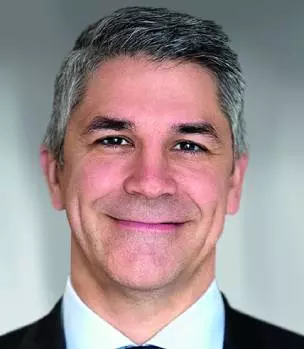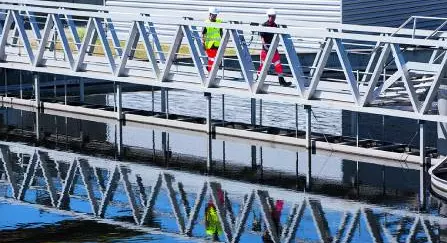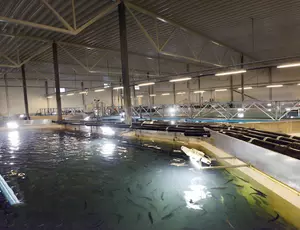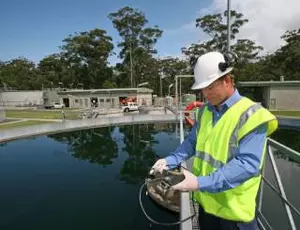Whether sudden like the COVID-19 pandemic or weather events, or diffuse like declining biodiversity or water pollution, concurrent crises highlight the urgent need to coordinate more integrated forms of water management. We will need to manage uncertainty going forward. Cross interview.

Xavier Leflaive
Principal Administrator, OECD Environment Directorate

Jean-François Nogrette
Chairman of Veolia Water Technologies
The crises currently affecting our world — climate, social, health, economic, linked to pollution or biodiversity — are occurring at ever greater frequency. To what extent is their convergence having an impact on water and its availability?
Jean-François Nogrette: I agree. The question of resilience is central. We learned a lesson when Hurricane Katrina hit New Orleans in 2005 and flooded our installations. We now protect them better, and we’ve strengthened defenses all over the world. The accumulation of diffuse pollution raises problems: water is a solvent and every river ultimately flows into the sea or ocean. Biodiversity loss threatens water's self-cleaning abilities. Finally, we also have to confront extreme weather events by optimizing our management modes: reducing water leakages, reusing water, desalination, and so on.

Xavier Leflaive: Every one of these crises affects demand for water and its availability. The climate emergency, in particular, highlights vulnerabilities to water-related risks. The financial and social dimensions of these crises can adversely impact the ability of governments and other actors to finance investments needed to ensure access to water and for protecting communities against water-related risks. There are two core lessons to take away. First, we need to change how we plan for the future, acknowledging uncertainty, placing greater importance on the ability to stay flexible, to adapt and avoid becoming trapped on pathways that may prove unsuitable. This requires new methods for planning the amount of water we need, and the investments required. Second, we’re seeing that these crises are concurrent and have to be managed in a coordinated fashion. COVID-19 hasn’t slowed down the climate emergency and its impact on water demand and availability.
For water managers, the main threat is biodiversity loss. Jean-François Nogrette
How can digital technologies help identify solutions to meet the scale of these crises affecting water management?
X. L.: Digital opens a fast-moving and highly diverse range of possibilities. They include monitoring and reporting techniques as well as data processing and modelling using big data. Other technologies are emerging, such as video and shape recognition. When used in network management, these technologies help optimize network operation and maintenance, providing enhanced oversight of water quality. New applications are improving relationships with users: residents in Busan, South Korea, for example, are able to access real-time information about water quality in their network.
J.-F. N.: Digitization is part of our day-to-day operational reality. In a crisis situation, digital tools, while less effective than the operator, are great for spotting if a machine becomes less efficient over time. Our Hubgrade solution considerably reduces water quality non-compliance by detecting variations that are invisible to the naked eye, thus avoiding the need for chemical treatments. In the Danish capital Copenhagen, integrated management of the sewer system and wastewater treatment plant is combined with close monitoring of weather forecasts so we can plan ahead for rainfall and maximize use of the entire network, avoiding overflows. And digital technologies make remote operations possible. During the pandemic, if we couldn’t send experts to a site, we could use augmented reality to assist plant operators during restart procedures.
The health crisis triggered by COVID-19 has had a significant impact on human activities for more than a year. How does it affect management of water resources?
J.-F. N.: Much is being demanded of Veolia during these uncertain times, in common with all other essential services. In manufacturing, process water requirements are critical and have to be altered rapidly. Hospitals and the pharmaceutical industry need large quantities of ultra-pure water. The drugs industry also produces hazardous waste and, worldwide, we have maintained operation of facilities that treat water containing toxic waste. The health crisis has also led us to develop expertise in tracking pathogens in wastewater, providing an indicator for health in the general population. VIGIE COVID-19 and VIGIE COVID-19 PLUS detect and determine the level of coronavirus and its variants in wastewater. We were the first company able to quantify variants in wastewater.
X. L.: Most of the direct impacts are linked to changes in demand and the capacity to finance services. Demand in business districts is falling, with less water being used in offices, but rising in residential areas as a result of people working from home. This may impact water companies’ revenue streams. And, against the background of the health crisis, governments have removed sanctions on users who fail to pay their water bills. Although this can help households in need, it also weakens the ability of public or private water companies to finance their network’s operating and maintenance costs in the future.
Veolia and COVID-19
Right from the start of the pandemic, Veolia developed two solutions: VIGIE COVID-19 to detect the presence of coronavirus in wastewater treatment plants and VIGIE COVID-19 PLUS to track and quantify its variants.
Find out more
Are we seeing geographical disparities in water management in parts of the world impacted by the heath crisis?
J.-F. N.: The whole world is adapting to governmental regulations and arrangements. In the Middle East, where we are building three major desalination plants, in the United Arab Emirates, Saudi Arabia and Bahrain, our construction sites were locked down so that construction work would not be impacted. In Guayaquil, Ecuador, deliveries of water to people living in areas without access to the water network continued uninterrupted. Singapore has accelerated water reuse, including for drinking water. Continuity of service was maintained everywhere, including under very difficult conditions.
Meeting growing demand for water is a planet-wide challenge. How is it possible to reconcile protecting water resources with ensuring its availability in a spirit of fairness?
X. L.: The two go together. Preserving water resources is the best way to ensure that water of appropriate quality will be available for a multitude of uses. Protecting ecosystems and biodiversity contributes to the proper management of water: responsible land use, wetland and forest conservation, and so on. You also need to pay very close attention to ensuring that water is used efficiently. This begins with making sure that the frameworks used for allocating water resources are aligned correctly with the future challenges. Most countries have set up allocation frameworks that offer some degree of sophistication. However, these systems are usually built to reflect problems of the past, and they now need reform to properly reflect the challenges that lie ahead. Work by the OECD shows that reforming these systems takes time. Efficiency in the network and the capacity to reuse treated wastewater also have a role to play by reducing losses. Aside from specifics about the technologies used, above all this requires unambiguous and deliverable standards to be set in terms of the water quality required for each type of use.
The capacity to reuse treated wastewater requires above all unambiguous and deliverable standards rather than technologies. Xavier Leflaive
J.-F. N.: Keeping a close eye on infrastructure quality certainly helps to limit leaks. Reuse is also a source of innovations, particularly for industry. In China, Mexico and South Africa, Nestlé makes powdered infant formula from cow’s milk extracting the water and reusing it in the Nestlé's production loop so it no longer needs to take water from the environment for its factories. In farming, using organic fertilizers paves the way to solutions that cause less pollution and use less water. Using Recirculating Aquaculture System (RAS2020) technology, salmon farms use small quantities of recycled water. Aquaponics is another solution, combining fish farming and market gardening. We are moving towards an integrated, territory-based model for water management, where barriers between farming, urban and industrial uses are increasingly blurred. Loops are emerging between different users. We are now producing drinking water from wastewater. In Namibia, wastewater already provides 35% of the water used by people in the capital, Windhoek. In Australia, treated water from coal gas plants run by QGC is used to irrigate farmland. Maximizing wastewater reuse is an excellent example of a circular economy solution.
We are moving towards an integrated, territory-based model for water management, where barriers between farming, urban and industrial uses are increasingly blurred. Jean-François Nogrette
How does the OECD encourage member countries to ensure industrial companies take greater account of the scarcity of water in their industrial processes?
X. L.: We work on two areas directly relevant to industrial uses. First of all, improving water allocation frameworks has impacts for industrial uses. Frameworks can be dissuasive for uses that add little value where water is scarce. We have also worked on technological innovations in water, an industry that is full of ideas. Ensuring wider uptake of these technologies is still a weak point. This should happen not so much through subsidies as through policies that recognize water’s value, for example, by making sure that pollution comes at a price. Regarding emerging forms of pollution such as pharmaceutical residues, microplastics from textiles and tires, a recent OECD report shows that every stage of their lifecycles must be taken into account to promote circular economy solutions, an approach that entails responsibilities on the part of companies that produce and market these products.
Ensuring wider uptake of these technologies should happen not so much through subsidies as through policies that recognize water’s value, for example, by making sure that pollution comes at a price. Xavier Leflaive
What other significant threats are there to sustainable management of water resources during the decade ahead? What are your recommendations for avoiding these threats?
J.-F. N.: Rapid urban growth means sanitation is a major issue that remains to be addressed. Another issue is the more widespread use of desalination, with an ever-growing need to increase the amount of renewable energies used. Reuse is a further challenge, in terms of keeping a watch on water quality and of choosing the least polluting energy sources. Finally, there is the threat of pollution in diluted forms. Water from industrial sites is often mixed with municipal wastewater, making treatment very expensive. Ideally, manufacturers need to treat wastewater close to their production sites and opt for reuse.




